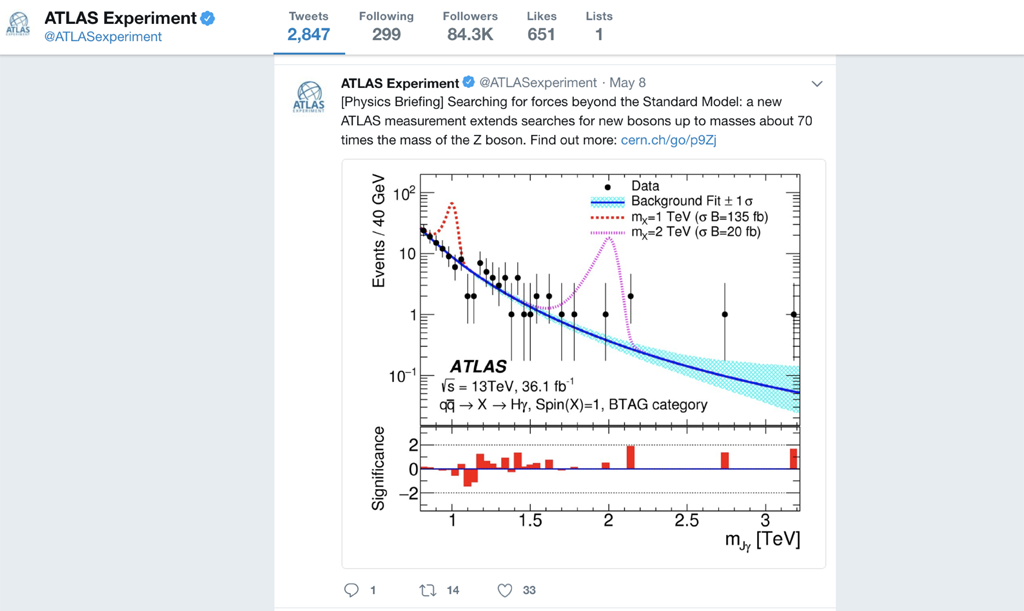
On May 8th, 2018, ATLAS collaboration, being one of the main experiments at LHC CERN and consisting of ~3000 scientists all over the world, released the latest results on the search for the new physics via heavy resonance signatures in the diboson W/Z/H+photon final states (arXiv: 1805.01908).
http://atlas.cern/updates/physics-briefing/searching-forces-beyond-standard-model
https://twitter.com/ATLASexperiment/status/993840433825501184

On May 30th, 2018, this result was chosen by ATLAS as one of its annual physics highlights to be presented at the LHCC opensession, with dedicate emphasis as “first search for a massive boson X decaying to Hγ”.

By means of careful optimizations, categorizations and combinations of the searched phasespaces, ATLAS managed to obtain the most stringent diboson search cross section limits on the heavy resonance decaying into the W/Z/H+photon final states, for the 1sttime up to the invariant mass of 6.7TeV in ever searched diboson channels. This work provides the latest and most stringent constraints on the new theory models that predict narrow width heavy particles decaying into W/Z/H+photon. Using the same amount of proton-proton collision dataset, the CMS physics results on Z+photon search only manages to probe the new physics limit up to 4TeV invariant mass. Moreover, the ATLAS result also provide, for the first time in the world, the search limits on the cross section of a heavy vector boson decaying into H+photon final states.


This work has been led and completed by Dr. Shu LI, the T.D. Lee Junior Fellow of Tsung-Dao Lee Institute (TDLI) and Institute of Nuclear and Particle Physics (INPAC) School of Physics and Astronomy, Shanghai Jiao Tong University, and Dr. Zhijun LIANG, the associateresearch fellow of Institute of High Energy Physics, Beijing. Being one of the two analysis coordinators, Dr. Shu LI has introduced for the first time the benchmark model of Higgs+Photon heavy resonances into the LHC experimentphysics analysis, and has initiated and driven the analysis process till the final accomplishment.
Dr. Shu LI did his undergraduate study at the Special Class for Gifted Young (SCGY) in University of Science and Technology of China (USTC) and graduated in 2008. After that, he continued his gradschool at the Department of Modern Physics, USTC, under the supervision of Prof. Zhengguo ZHAO, academician of Chinese Academy of Sciences, where he finished his physics PhD thesis half a year ahead of schedule at the end of 2012. Starting from 2013, he worked as postdoctoralresearch fellow at Duke University and based at CERN, deeply involved in the research on the high energyfrontierexperimental particle physics with the ATLAS experiment. He joined the newly founded Tsung-Dao Lee Institute as the 1st“T.D. Lee Junior Fellow”, co-appointed by the Institute of Nuclear and Particle Physics, School of Physics and Astronomy, Shanghai Jiao Tong University. Dr. Shu LI has quite a few remarkable research achievements in his career, such as: the precisemeasurement of the Standard Model background of Higgs to WW which greatly helped with the Higgs discovery in 2012, the first observantion of tribosonZγγ rare process at LHC and probe of anomalous gauge couplings, the first ATLAS measurement of electroweakZγ+jjprocess with vector boson scatteringtopology, the search for heavy resonances decaying into Z+photon which greatly helped to resolve the 750GeV puzzle in 2016, the first ever search for heavy resonances decaying into Higgs+photon final states at LHC. With the high recognition of his contribution, he has been appointed by the ATLAS collaboration (~3000 members in the world) to several important leadershippositions such as: 2015/12-2017/01, the convener of the Monte Carlo Validation Group; 2017/04-2018/03, the convener of the Standard Model Electroweak (SM-EWK) Physics Group; 2018/04-Present, the convener of the Monte Carlo Generator Development and Tuning Group. Especially, the SM-EWK group has got ~200 participants from ~50 different research institutions worldwideincludingHavard, UC Berkeley, Oxford, Michigan etc., working on tens of multiboson production measurement and anomalous coupling search topics. He has been the 1st Chinese scholar in ATLAS collaboration to lead three different working groups, all of which are appointed during data-taking.




